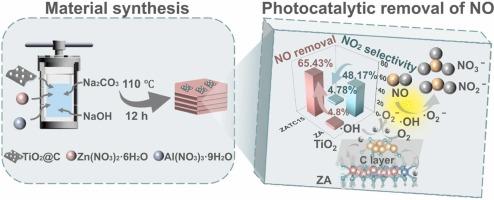Highly efficient photocatalytic removal of NO and synchronous inhibition of NO2 via heterojunction formed by ZnAl-LDH and MXene-Ti3C2-derived TiO2@C
IF 12.2
1区 环境科学与生态学
Q1 ENGINEERING, ENVIRONMENTAL
引用次数: 0
Abstract
The key challenge in oxidizing NO using photocatalysis is controlling the selectivity of products to avoid the generation of toxic byproducts like NO2. Here, we propose regulating the generation of reactive oxygen species by constructing Type-II heterojunctions to facilitate the deep oxidation of NO to nitrates. Experimental characterization and Density Functional Theory (DFT) simulations demonstrate that the outstanding photocatalytic activity of heterojunction materials stems from their superior charge separation efficiency and stronger adsorption capacity for NO and O2 molecules, promoting the formation of reactive oxygen species. These results indicated that the best-performing sample, ZATC15, demonstrated an impressive NO removal efficiency of 65.43%. However, the selectivity rate of NO2 was only 4.78%, much lower compared to the NO2 selectivity rates of pure ZnAl-LDH (48.17%) and TiO2@C (72.46%). The intermediate and final products, the generation pathways of active free radicals (h+ and •O2-) and the mechanism behind the profound oxidation of NO were elucidated based on in-situ Fourier Transform Infrared Spectroscopy (in-situ FTIR), Electron Spin Resonance (ESR), and capture experiment. This investigation will offer valuable insights for modifying LDH in order to effectively remove ppb-level NO through photocatalysis.

求助全文
约1分钟内获得全文
求助全文
来源期刊

Journal of Hazardous Materials
工程技术-工程:环境
CiteScore
25.40
自引率
5.90%
发文量
3059
审稿时长
58 days
期刊介绍:
The Journal of Hazardous Materials serves as a global platform for promoting cutting-edge research in the field of Environmental Science and Engineering. Our publication features a wide range of articles, including full-length research papers, review articles, and perspectives, with the aim of enhancing our understanding of the dangers and risks associated with various materials concerning public health and the environment. It is important to note that the term "environmental contaminants" refers specifically to substances that pose hazardous effects through contamination, while excluding those that do not have such impacts on the environment or human health. Moreover, we emphasize the distinction between wastes and hazardous materials in order to provide further clarity on the scope of the journal. We have a keen interest in exploring specific compounds and microbial agents that have adverse effects on the environment.
 求助内容:
求助内容: 应助结果提醒方式:
应助结果提醒方式:


